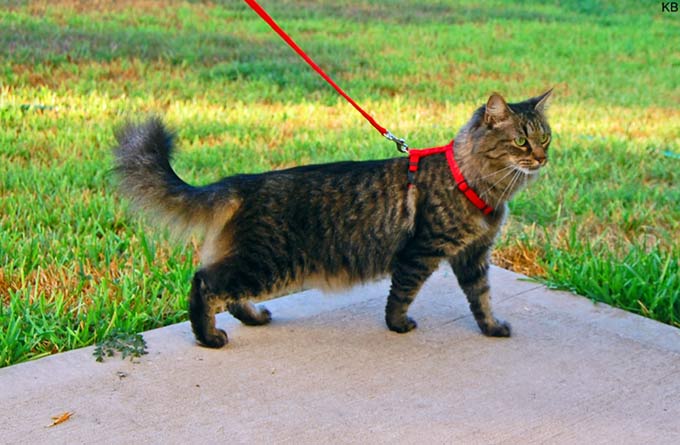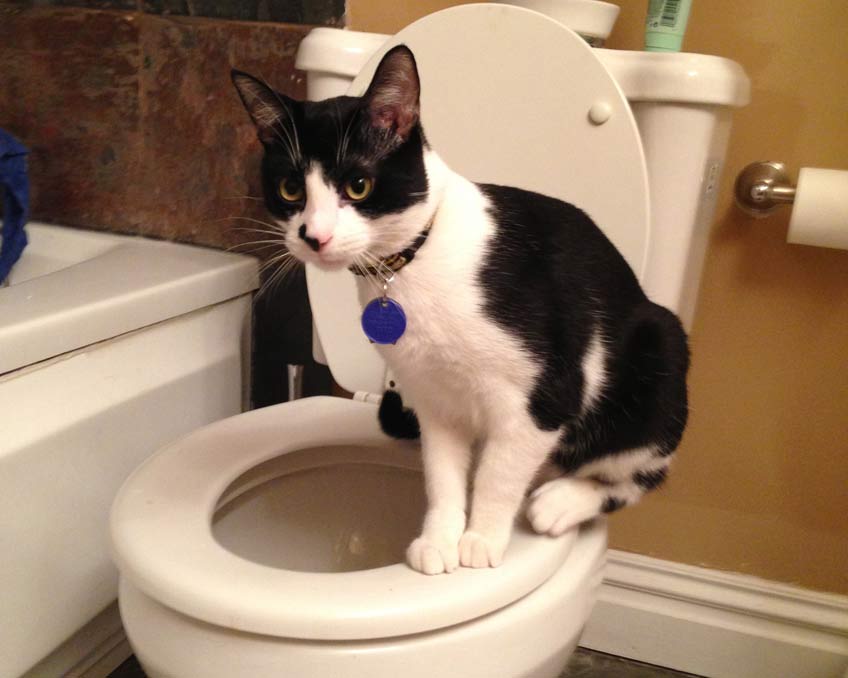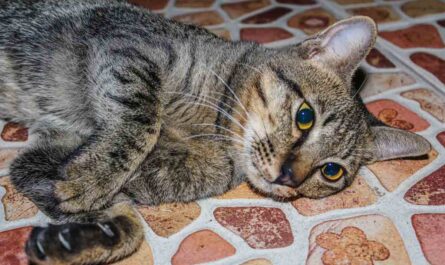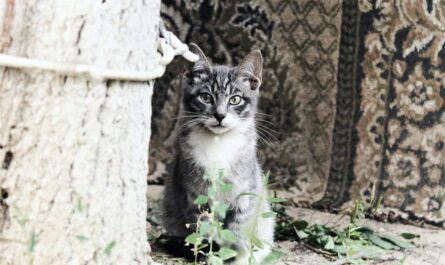Do cats have scent glands in their paws? Have you ever curled up on the couch with your feline companion, only to be met with a rhythmic kneading of their paws on your lap? As their soft pads press against you, a faint, almost musky scent might tickle your nose. This seemingly affectionate behavior raises an intriguing question: do cats have scent glands in their paws?
The answer, dear reader, is a fascinating exploration into the secret world of feline communication. Cats, those enigmatic creatures who grace our homes with their presence, possess a hidden language – a language not solely spoken through meows and purrs, but also communicated through scent. This article delves into the science behind scent glands in cats, with a particular focus on those nestled within their paws. We’ll uncover the secrets these glands hold, how they play a crucial role in marking territory and feline social interactions, and how different cat behaviors utilize this remarkable olfactory communication system.
By the end of this journey, you’ll gain a deeper understanding of your furry friend’s fascinating communication methods. We’ll also explore some helpful tips for managing any potential scent-marking issues, ensuring a harmonious coexistence between you and your feline companion. So, settle in, cat lovers, and prepare to embark on a delightful exploration of the intriguing world of feline scent glands!
A World Beyond Sight: The Diverse Scent Glands of Cats
We all know cats have exceptional vision, capable of spotting the tiniest flicker of movement in the dimmest light. But their sensory superpowers extend far beyond sight. Cats possess an incredibly acute sense of smell, playing a vital role in their daily lives and social interactions. This section delves into the fascinating world of feline scent glands, specialized structures that act as tiny perfume factories, silently broadcasting messages to other cats and shaping their behavior.
Beyond the Fur: A Deeper Look at the Feline Sensory World
Have you ever noticed your cat intently sniffing every corner, lamppost, or unfamiliar object during your walks? This inquisitive sniffing isn’t just about curiosity; it’s their way of deciphering the world around them. Unlike humans who rely primarily on sight, cats perceive their environment through a combination of senses, with smell playing a dominant role.
The feline sense of smell is estimated to be roughly fourteen times stronger than our own! This incredible olfactory prowess allows them to detect subtle nuances in scents that are completely imperceptible to us. It’s like having a built-in super sniffer, constantly gathering information about their surroundings.
A Network of Communication: The Language of Pheromones
But scent does more than just inform cats about their environment. It also serves as a sophisticated communication tool. Hidden throughout their bodies are specialized glands that produce unique chemical messages called pheromones. These pheromones act like invisible whispers, conveying information to other cats without a meow or a hiss.
Imagine your cat leaving a tiny scent message on a scratching post, declaring, “This is my territory!” Or a mother cat leaving comforting pheromones on her kittens to guide them back to the nest. Pheromones play a crucial role in feline social interactions, marking territory, establishing hierarchy, attracting mates, and even fostering feelings of security and calmness.
Mapping the Scentscape: A Cat’s Olfactory Signposts
Now that we understand the significance of scent in a cat’s world, let’s explore the hidden map of scent glands that equip them with this remarkable communication ability. These glands are strategically located throughout a cat’s body, each with a specific function.
-
Facial Glands: These glands are situated around the head, most notably near the cheeks, forehead, and lips. When a cat rubs its head against you, furniture, or another cat, it’s depositing these pheromones, leaving a friendly scent mark and saying, “Hello! I consider you a friend.”
-
Interdigital Glands: These tiny glands are located between the paw pads of your feline friend. Every time your cat kneads or scratches a surface, they’re not just giving themselves a massage; they’re also leaving behind scent messages with their paws!
-
Anal Glands: These glands, located near the base of the tail, produce a stronger scent that serves as a territorial marker. Thankfully, under normal circumstances, these glands empty discreetly during bowel movements.
-
Flank Glands: Situated on either side of the body, near the lower back, flank glands are another area where cats can leave scent messages. These glands are often activated during stressful situations, such as meeting a new pet.
By understanding the location and function of these scent glands, we gain a deeper appreciation for the complex world of feline communication. The next time your cat gives you a head nudge or leaves a strategic “gift” on the carpet, remember, it’s not just random behavior; it’s their way of leaving a scented message, navigating their social world, and connecting with their environment.
The Science of Scent: Demystifying Pheromones
Have you ever witnessed your cat rub their head against your leg, knead your favorite blanket with their paws, or leave a strategic “gift” (hairball, anyone?) in an unexpected location? These seemingly peculiar behaviors might hold a deeper meaning, a silent conversation in the language of scent. Cats, along with many other animals, possess a fascinating olfactory superpower – the ability to communicate through pheromones.
Chemical Conversations: A Silent Language
Pheromones are chemical messengers, odorless to humans but detectable by other cats. These tiny molecules released by various glands on a cat’s body carry specific information, like a whispered message in the air. While we may not be able to perceive these scents, they play a crucial role in feline communication, influencing everything from territorial claims to social interactions.
Imagine your cat rubbing their head against the corner of your sofa. In that seemingly affectionate gesture, they might be depositing pheromones that signal their presence and declare, “This is my domain!” These territorial markers act like invisible boundary lines, informing other cats that this particular space is occupied.
Types of Feline Pheromones: A Chemical Cocktail
The world of feline pheromones is surprisingly diverse, with different types carrying distinct messages. Here’s a glimpse into some of the most common ones:
- Territorial Markers: As mentioned earlier, these pheromones help cats establish and maintain their territory. They can be deposited on furniture, walls, or even your unsuspecting leg, acting as a chemical “This is mine” sign for other felines.
- Sexual Signals: During mating season, both male and female cats release pheromones that advertise their availability and receptiveness to potential partners. These “feline flirtations” play a significant role in feline courtship behavior.
- Calming Pheromones: In contrast to the territorial or sexual messages, cats also produce pheromones that have a calming effect. These pheromones, often released by mother cats to comfort their kittens, can also be synthetically replicated and used in diffusers or sprays to help ease feline anxiety in stressful situations, like moving to a new home or introducing a new pet.
Decoding the Message: The Power of Perception
When a cat encounters a pheromone message left behind by another feline, they interpret the information based on their own needs and experiences. For instance, if a territorial marker is detected, it might trigger a defensive response, while a sexual pheromone from a potential mate could spark interest and courtship behavior.
Understanding the role of pheromones sheds light on many feline behaviors. The next time your cat seems inexplicably drawn to a specific corner of the room or displays sudden aggression towards an unseen visitor, it might be due to a silent conversation happening in the language of scent.
The Power of the Paw: How Cats Use Scent Glands in Communication
Our feline companions may not bark or roar, but they have a unique way of making their presence known – through scent! Cats possess a sophisticated olfactory (sense of smell) communication system, and their paws play a crucial role in this silent language. Tucked between their little toe pads lie special glands called interdigital glands, which produce pheromones – chemical messengers that can be detected by other cats. Let’s delve into the fascinating world of feline paw scents and explore how cats use them to navigate their social world.
Marking Their Territory: A Silent Announcement
One of the primary functions of paw scent glands is territory marking. Imagine your cat confidently strutting around the house, occasionally stopping to give your favorite armchair a good scratch. This isn’t just about sharpening claws; it’s a strategic act of communication. As your cat scratches, they deposit tiny amounts of pheromones from their interdigital glands onto the surface. These pheromones act as a message to other cats, declaring, “This is my space!” It’s a way for them to establish their domain and feel secure within their environment.
Decoding the Scratch: The frequency and intensity of scratching can also provide clues about your cat’s emotional state. A relaxed and confident cat might leave a few gentle swipes, while a stressed or anxious cat might engage in a more frantic scratching frenzy. Understanding these subtle cues can help you better connect with your feline friend.
More Than Just a Scratch: Kneading for Comfort and Communication
Have you ever witnessed your cat kneading your lap or a favorite blanket with their paws? This rhythmic kneading behavior, often accompanied by gentle purring, might bring back memories of nursing kittens. While it can be a sign of contentment and a throwback to their kittenhood, kneading also serves a scenting purpose. As your cat kneads, they are subtly deposit pheromones onto the surface, creating a sense of familiarity and security. It’s their way of marking an object or person as safe and loved.
Beyond Kittens: Interestingly, not all cats knead. This behavior is more commonly observed in younger cats, but some adult cats retain this habit well into their senior years. It’s a comforting and self-soothing activity for them, and the presence of your familiar scent on the kneaded object likely adds to their sense of calm.
Social Greetings: A Subtle Scent Exchange
While scent marking is primarily a territorial behavior, there’s a chance that paw scents might also play a role in social greetings between cats. When two friendly cats meet, a gentle touch of paws might be a way to exchange scents and assess compatibility. This brief exchange allows them to gather information about each other, promoting a peaceful interaction.
A World of Nuance: The exact role of paw scents in feline social interactions is still being explored by animal behaviorists. However, it’s fascinating to consider that these tiny glands on their paws contribute to the complex social lives of our furry companions.
A Symphony of Scents: Exploring Scent-Marking Behaviors in Cats
Our feline companions are fascinating creatures with unique ways of communicating. One such method involves a secret language – the language of scent! Cats possess a remarkable array of scent glands located throughout their bodies, including their paws. But have you ever wondered why your cat scratches the furniture, leaving little marks, or kneads your lap with those adorable paws? The answer lies in this intriguing world of feline scent marking.
Scratching Posts and More: A Cat’s Communication Network
Have you noticed your cat enthusiastically scratching at the sofa or a favorite chair? While it might seem like destructive behavior, this act is actually a natural and essential part of feline communication. Cats have scent glands located between their paw pads, called interdigital glands. When they scratch, these glands release pheromones, special chemical messengers that carry information about the cat.
Scratching serves several purposes for our furry friends. It helps them:
- Mark their territory: By scratching and leaving their scent, cats claim ownership of their space, sending a message to other cats that this area belongs to them.
- Maintain healthy claws: Scratching is a natural way for cats to remove the outer layer of their claws, keeping them sharp and trimmed.
- Stretch and exercise: Scratching allows cats to stretch their bodies and flex their muscles, promoting good posture and overall physical well-being.
Providing the Right Outlet: To prevent your furniture from becoming the target of your cat’s scratching needs, it’s crucial to offer them appropriate scratching posts. Look for sturdy posts made of sisal or cardboard, materials that mimic the texture of tree bark (a natural scratching surface for outdoor cats). Place scratching posts in prominent locations where your cat likes to spend time and encourage their use with catnip or praise.

Urine Spraying: Beyond the Paw Prints
It’s important to distinguish between scent marking with paw glands and urine spraying. While both behaviors involve leaving a scent message, urine spraying is a more intense form of territorial marking. Cats typically spray urine vertically on walls, furniture, or doors. This behavior can indicate feelings of stress, anxiety, or insecurity in your cat.
Understanding the Cause: If your cat suddenly starts urine spraying, it’s essential to identify the underlying cause. Here are some potential triggers:
- New additions to the household: A new pet, baby, or even a change in furniture can cause stress in your cat, leading to urine spraying as a way to reassert their dominance.
- Changes in routine: Cats are creatures of habit, and disruptions to their daily schedule, like a change in feeding times or litter box location, can trigger anxiety and scent marking.
- Unfamiliar scents: New smells in the environment, such as a neighbor’s cat coming too close to a window, can make your cat feel threatened and prompt them to spray urine to mark their territory.
Addressing the Issue: If you suspect your cat is urine spraying, a trip to the veterinarian is recommended to rule out any underlying medical conditions. Once the cause is identified, you can take steps to address it. This might involve providing additional hiding spots for your cat to feel secure, introducing new pets or babies slowly, or maintaining a consistent routine. Enzymatic cleaners specifically designed for pet accidents can help eliminate lingering odors and discourage further spraying.
Factors Influencing Scent Marking: A Delicate Balance
Several factors can influence the frequency and intensity of scent marking in cats. Here are some key considerations:
- Age: Kittens typically don’t start scent marking until they reach sexual maturity, around 6-8 months old.
- Sex: Neutered males and spayed females are generally less likely to exhibit scent-marking behavior.
- Stress: As mentioned earlier, any situation that causes stress or anxiety in your cat can trigger increased scent marking.
By understanding the reasons behind your cat’s scent-marking behaviors, you can create a more harmonious and stress-free environment for both of you. Remember, positive reinforcement and addressing the root cause are key to minimizing unwanted marking and fostering a happy feline relationship.
Understanding the Message: Tips for Managing Scent Marking
Have you ever noticed your feline friend leaving what seems like invisible messages around your home? Those little scratches on the doorframe or that unexpected puddle on the rug might be your cat’s way of communicating through scent marking. While this behavior can be frustrating for pet parents, it’s important to understand the reasons behind it and explore solutions that address the root cause.
This section delves into the fascinating world of feline communication and offers tips to manage scent marking positively and constructively.
Environmental Enrichment: A Stimulating World for Scratching
Cats are territorial creatures with an instinct to mark their domain. One way they achieve this is by scratching surfaces and leaving behind a combination of visual marks from their claws and scent messages from specialized glands located on their paws.
The good news is that you can provide your cat with a more appropriate outlet for their scratching needs by enriching their environment. Here’s how:
-
Scratching Post Paradise: Provide your cat with multiple scratching posts strategically placed around your home, especially in areas they frequent. Choose scratching posts made from different materials (sisal, cardboard) to cater to your cat’s preferences. Vertical scratching posts allow for a full-body stretch, while horizontal options mimic scratching on the ground.
-
Climbing the Walls (Responsibly): Cats are natural climbers, and offering them climbing structures like cat trees or wall-mounted shelves can help reduce their desire to scratch furniture. These structures provide vertical territory for your cat to explore and perch on, positively fulfilling their instincts.
-
Hiding in Plain Sight: Cats also feel secure having designated hiding spots. Cat caves, tunnels, or even cardboard boxes strategically placed around the house can provide your feline friend with a sense of security and a place to retreat when they feel overwhelmed. By offering these enrichment options, you’re creating a stimulating environment that caters to your cat’s natural behaviors, potentially reducing their reliance on scent marking.
Positive Reinforcement: Rewarding Good Choices
Cats are intelligent creatures who respond well to positive reinforcement. When you catch your cat scratching an appropriate surface like their scratching post, reward them with praise, petting, or a treat. This positive association helps them understand what scratching behavior is desirable and encourages them to repeat it.
Here are some additional tips for positive reinforcement:
- Make it Fun: Sprinkle some catnip on your scratching posts to entice your cat and make scratching more appealing.
- Location, Location, Location: Ensure your scratching posts are placed in convenient locations, especially near areas your cat frequents or where they have previously scratched furniture.
- Be Patient: Changing ingrained behavior takes time and consistency. Be patient and persistent with positive reinforcement, and gradually you’ll see a positive shift in your cat’s scratching habits.
Addressing Underlying Issues: Ruling Out Medical Causes
Sometimes, excessive scent marking can be a sign of an underlying medical condition, such as a urinary tract infection (UTI) or bladder stones. If your cat exhibits a sudden increase in scent marking alongside other symptoms like difficulty urinating, blood in the urine, or straining in the litter box, it’s crucial to schedule a visit with your veterinarian to rule out any medical causes.
Seeking Professional Help: When to Call in the Experts
If you’ve tried environmental enrichment, positive reinforcement, and ruled out medical causes, yet your cat continues to exhibit excessive scent marking, consider seeking professional help. A certified animal behaviorist can assess your cat’s individual situation and provide personalized strategies to address the behavior.
Remember, a little understanding and some creative solutions can go a long way in managing scent marking and creating a harmonious living environment for both you and your feline companion.
Beyond the Scratch: The Secret Language of Cats
Cats are captivating creatures, often shrouded in an air of mystery. They purr with contentment, swat at dangling toys with playful ferocity, and leave behind the occasional curious scratch on your favorite armchair. But have you ever wondered what these behaviors mean? Turns out, there’s a whole world of feline communication happening right under our noses, or should we say, right under our observant eyes!
Decoding the Messages: A Multi-Sensory Approach
Cats are complex communicators, relying on a combination of scent, vocalizations, and body language to express themselves. Their keen sense of smell plays a particularly fascinating role. Imagine your cat rubbing their head against your leg, leaving behind a subtle (to us) scent. This, in the feline world, is a friendly greeting, a way of marking you as part of their inner circle.
-
Scent Marking: A Social Currency: Cats have scent glands located on their paws, cheeks, forehead, and tail. These glands release pheromones, chemical messengers that can be detected by other cats. When a cat scratches a post or rubs against furniture, they’re depositing these pheromones, essentially saying, “This is my territory!” This behavior isn’t meant to be malicious; it’s a way for them to feel secure and communicate with other feline housemates (or neighborhood strays!).
-
Understanding Meows and More: Of course, vocalizations are another key part of feline communication. That familiar “meow” can have a range of meanings depending on the pitch and duration. A soft meow might be a request for food, while a long, drawn-out meow could indicate distress. Don’t forget about purrs! These rumbling vibrations are generally a sign of contentment, but can also sometimes indicate that your cat is seeking comfort or attention. Business – Money Making – Marketing – E-commerce
-
Body Language Speaks Volumes: A cat’s body language can be a treasure trove of information. A swishing tail might signal irritation, while a relaxed posture with a gently swaying tail likely indicates contentment. Pay attention to your cat’s ears as well. Flattened ears can be a sign of fear or aggression, while perked-up ears suggest curiosity or alertness.
By familiarizing yourself with these different forms of feline communication, you can gain a deeper understanding of your furry companion’s needs and feelings.
Building Bridges with Your Feline Friend
Understanding scent marking isn’t just about interpreting your cat’s behavior; it can also help strengthen the bond between you. Here’s a secret: you can use scent to your advantage! Feliway, a synthetic pheromone product, can be a lifesaver in multi-cat households or for cats struggling with anxiety. It mimics calming feline pheromones, creating a more harmonious environment.
Similarly, providing scratching posts allows your cat to indulge in their natural instinct to scent mark in a designated location, saving your furniture from unwanted attention.
Creating a Cat-Friendly Oasis
Cats are creatures of comfort and routine. By creating a home environment that caters to their natural communication needs, you can foster a sense of security and well-being for your feline friend.
-
Provide Vertical Territory: Cats love to climb and perch, so consider adding cat trees or shelves to their environment. This allows them to survey their domain from a high vantage point and feel more secure. Cat accessories on Amazon
-
Scatter Scratching Posts: Distribute scratching posts throughout your home, especially near furniture or areas your cat frequents. This provides them with appropriate outlets for their scratching instincts.
-
Respect Their Scent Markings: While the occasional scratched post might not be ideal, punishing your cat for scent marking is counterproductive. Instead, focus on positive reinforcement and provide them with acceptable alternatives.
Understanding your cat’s communication style, including their use of scent marking, is the key to building a strong and trusting relationship. By creating a cat-friendly environment that caters to their natural instincts, you can transform your home into a haven for your furry friend, filled with mutual respect, purrs, and playful swats at dangling toys.
Other Interesting Articles
- How to Help Your Cat Overcome Fears in 13 Strategic Steps
- 13 Easy Tricks To Teach Your Cat: Basic Feline Training Guide
- How To Train Your Cat: 15 Easy Steps To Teach New Things
- Why Do Cats Have Tails? 4 Fun Facts You Didn’t Know
- 16 Simple Ways To Establish A Stronger Bond With Your Cat
- How To Train Your Cat/Kitten To Sit: Steps, Command, Guide
- Cat Giving Birth: From Your Feline Pregnancy to Kitten Care
- Fading Kitten Syndrome: Age, Causes, Symptoms, Treatment
- Kitten Bottle Feeding: Chart, Tips, Recipe, Challenges, Guide
- Cat Pregnancy: Timeline, Signs, Labor, Behavior, Stages
- 16 Silent Killers of Cats Every Pet Owner Must Be Aware Of
- Do Mother Cats Discipline Their Kittens? A Guide To Owners
- How To Take Care of A Kitten 6 Weeks Old: A 7-Step Guide
- How To Tell If Your Cat is Trying to Hurt You: A To-Do Guide
- How To Tell If Your Cat Has Tapeworms: What You Can Do
- How To Tell If My Cat is in Pain After Neutering: What To Do
- How To Get A Cat To Trust You Fast: Signs, Tips, Techniques
- 12 Signs Your Cat is a Boy: Tips To Distinguish A Male Cat
- Single Kitten Syndrome: Age, Signs, Symptoms, Treatments
- How To Tell If Your Cat Can’t See Well: What You Can Do



